When you buy through our links, we may earn a commission. Products or services may be offered by an affiliated entity. Learn more.
Best CPAP Pillows
Continuous positive airway pressure (CPAP) is the frontline treatment for sleep apnea, a breathing condition which affects millions of Americans. While CPAP is a very effective treatment, some people struggle to adjust to the mask they must use every night. Accessories can make treatment more comfortable, and CPAP pillows are one of the most popular accessories for ensuring a good night’s sleep while using a CPAP machine.
CPAP pillows — not to be confused with CPAP nasal pillows, which are a type of low-profile mask — are pillows designed to accommodate a CPAP mask. They vary in design, but most have cut-outs or curves so that CPAP users can sleep on their side without their mask digging into their face. Other designs may be adjustable or stabilizing rather than accommodating. A CPAP pillow may also improve treatment efficacy by making it less likely for an active sleeper to dislodge their mask.
Choosing the right CPAP pillow depends on your personal preferences and budget, as well as what type of mask you use and your preferred sleep position. We’ll introduce you to our favorite models, then walk you through the most important factors to consider before making a purchase.
Our Top Picks
-
Best Overall – Borden Textile CPAP Pillow
View Details
-
Best for Neck Pain – Contour CPAPmax 2.0 Pillow
View Details
Swipe for more
Best Overall
Borden Textile CPAP Pillow
7.4 /10
Test Lab Score
The Borden Textile CPAP Pillow caters to sleepers who use CPAP devices, especially those who frequently experience therapy disruptions from jostled tubing. The plush design also offers plenty of cushioning for those who need it.
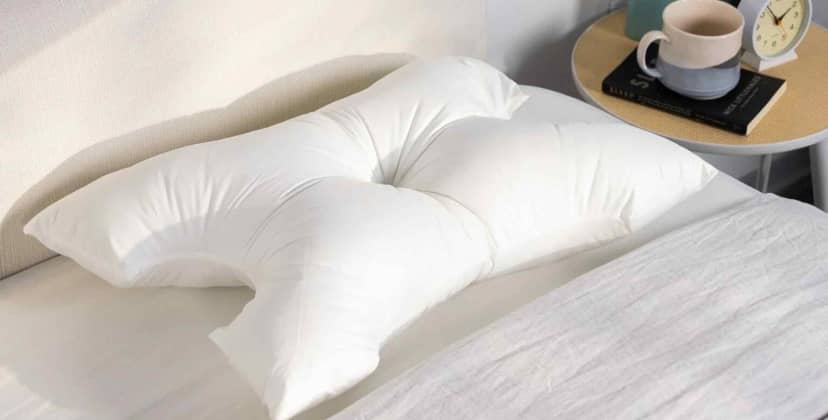
Credit: Sleep Foundation Test Lab
Price
$50
Fill
Polyester
Firmness
Medium
Full Details
A good CPAP pillow is one that keeps your head and neck properly aligned with your spine without jostling your CPAP mask in the middle of the night. The Borden Textile CPAP Pillow pulls off this feat thanks to a unique design that helps prevent excessive shifting of your mask and tubing.
What Does It Do?
The pillow is designed with ample cutouts on each side to allow space for your CPAP tubing and mask to rest while you sleep. This reduces the likelihood of dislodging your mask, which ultimately ensures more effective CPAP therapy. The pillow’s polyester fill is soft and plush, and it’s encased in a breathable cotton cover.
Who It’s Best For
The Borden Textile CPAP Pillow is well suited for side sleepers, since the cutout shape on the bottom allows space for the shoulder while maintaining support for the neck and head. Side sleepers are also more prone to hose and mask interference, so the cutout design is a noteworthy benefit. Back sleepers and combination sleepers will also find the cutout design advantageous for the same reasons as side sleepers.
The pillow is affordably priced compared to some other CPAP pillows we’ve reviewed. A small flat-rate fee is charged for shipping if you purchase the pillow on The Sleep Doctor.
Best for Neck Pain
Contour CPAPmax 2.0 Pillow
6.8 /10
Test Lab Score
Use this link for the most current Contour discounts
Use this link for the most current Contour discounts
Contour’s CPAPmax 2.0 is thoughtfully designed to meet the various needs of CPAP users. Side cutouts, a tube tether, and adjustable loft elevate this pillow over many competing models, and an approachable sticker price makes it a solid option for budget-conscious shoppers.
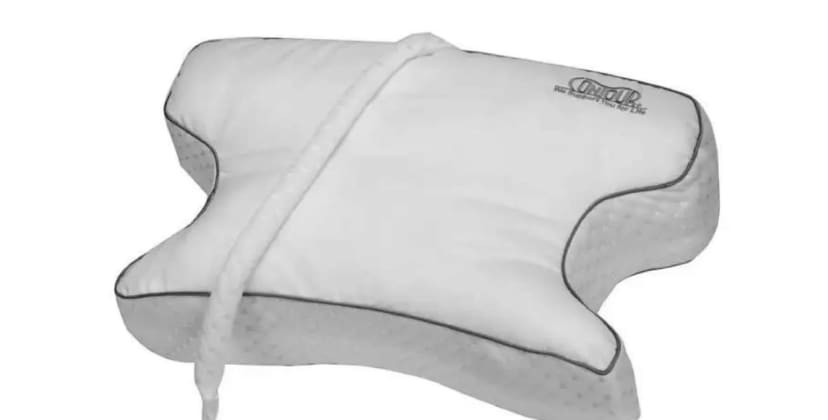
Price
$60
Fill
Memory foam with fiber fill, support polyfoam
Firmness
Medium Firm
Full Details
Comfortable sleep can be elusive for people who need CPAP therapy, and the wrong pillow can exacerbate this problem. The Contour CPAPmax 2.0 is equipped with features intended to stabilize your mask while you sleep, preventing rainout and reducing the potential for air leaks in the process. Adjustable loft and a breathable mesh cover further boost the pillow’s appeal for CPAP users.
What Does It Do?
The pillow’s core begins with a top layer of memory foam, followed by two layers of high-resiliency (HR) polyfoam that form a stable base. All three foam layers are ventilated to promote airflow throughout the interior, and the base layer is infused with charcoal for additional cooling. You can remove one or two of the layers to lower the profile if you normally sleep on your back or stomach. Regardless of how many inserts you use, the pillow feels fairly firm.
Both sides feature cutouts to support your face mask’s tubing. A tether attachment further stabilizes the tube by preventing it from tugging on or pulling away from your mask, which in turn reduces kinks and helps maintain steady airflow. A breathable cover with mesh side panels encases the inserts. You can remove and machine wash the cover as needed.
Who It’s Best For
While the adjustable design means you can lie comfortably on the pillow in any position, the side cutouts are especially useful for side sleepers. The CPAPmax 2.0 is also a good choice for combination sleepers who use more than one position on any given night, as the pillow is easy to adjust compared to models with shredded foam fill.
Although the pillow is compatible with many mask types, you may notice restricted airflow if your mask has top-of-head tubing. You may also notice some strong off-gassing when the pillow is new. These odors eventually dissipate, but people who are highly sensitive to smells might struggle for the first few nights.
The Contour CPAPmax 2.0 Pillow is competitively priced. If you purchase the pillow through Sleep Doctor and reside in the U.S., your order qualifies for reasonable flat-rate shipping. You may return the pillow unused and unopened within 60 days of delivery.
Best Travel CPAP Pillow
Core Products Mini CPAP Pillow
7.7 /10
Test Lab Score
Use this link for the most current Core Products discounts
Use this link for the most current Core Products discounts
Many CPAP pillows are composed of memory foam, but the Core Products Mini CPAP Pillow caters to sleepers who enjoy pillows with a fluffier feel. The compact size makes it ideal for travel.
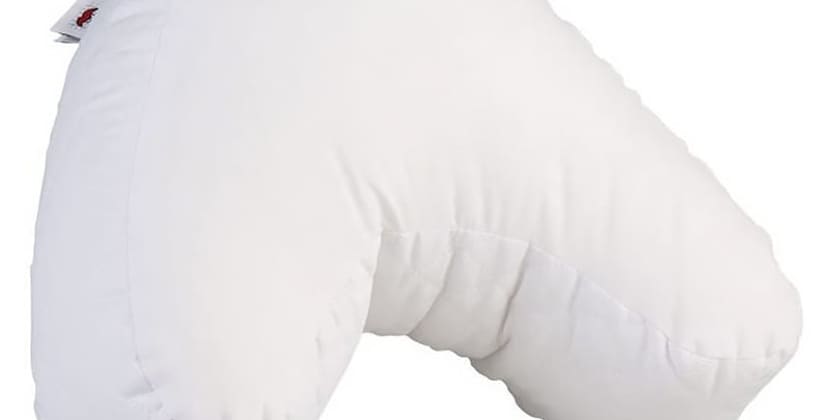
Price
$70
Fill
Down Alternative
Firmness
Medium
Full Details
Unlike most of the other CPAP pillows on the market, the Core Products Mini CPAP Pillow has a fairly simple design and a down alternative filling. The pillow provides surprisingly robust support to CPAP users regardless of their mask type or preferred sleeping position.
What Does It Do?
The Mini CPAP Pillow features a down alternative fill with a cotton cover that cannot be removed, though pillow cases can be purchased through the official Core Products website. While molded foam pillows are some of the most popular CPAP pillows, the crescent shape is one of the original CPAP pillow designs and is still quite effective at accommodating CPAP gear. The pillow is shaped to fit against the body without any excess, leaving plenty of room for whatever type of mask you use.
Who It’s Best For
The pillow’s lightweight design makes it a great choice for frequent travelers, including for use while traveling by air. It is effective for both side and back sleepers, although its design may be an adjustment for side sleepers accustomed to a larger pillow. Active side sleepers may also dislodge the pillow, as it requires fairly precise positioning. The Mini CPAP is also a good choice if you enjoy the feel of alternative down instead of memory foam.
The manufacturer stands behind its pillow with a 1-year warranty covering common manufacturing defects and flaws.
Best for Side Sleepers
Snugell CPAP Pillow for Side Sleeping
7.7 /10
Test Lab Score
The adjustable Snugell CPAP Pillow for Side Sleeping comes with four inserts you can add or remove to change the loft. Side sleepers who frequently deal with neck and shoulder strain should find this pillow particularly beneficial.
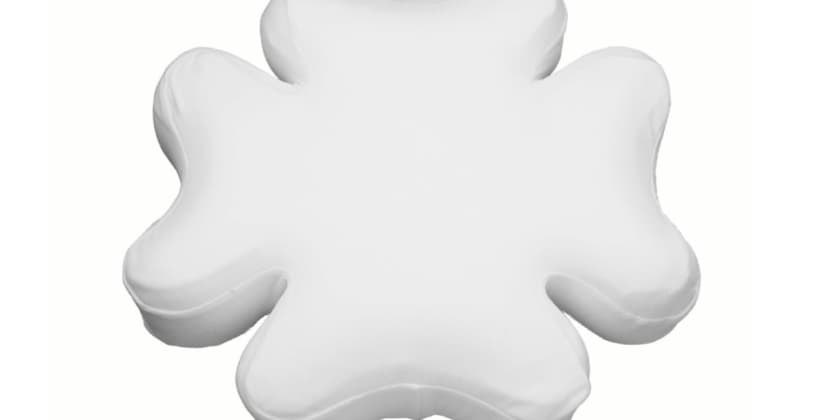
Price
$50
Fill
Memory Foam
Firmness
Medium Firm
Full Details
Many CPAP users prefer sleeping on their side because this can help expand their airway and reduce snoring – but at the same time, a side sleeper’s pillow can obstruct their CPAP machine’s connective tubing. The Snugell CPAP Pillow for Side Sleeping mitigates this issue with a sloped surface and open corners to accommodate your CPAP tubing and promote steady, uninterrupted airflow. An adjustable design with four profile options also ensures any side sleeper can find a comfortable loft level.
What Does It Do?
The pillow’s unique shape consists of sloped edges and cutouts in all four corners. This helps provide elevated neck support and cradling for the head, and also frees up space for your CPAP hose to fit without becoming crimped or stuck. Four memory foam inserts – or “leaves” – are included with each order. These leaves vary by thickness, allowing you to mix and match them to find your ideal loft. Side sleepers should maximize the thickness by using two or more leaves to get the cushioning they need for the space between their head and downward shoulders. Back and stomach sleepers may find a comfortable height with just one of the inserts.
Who It’s Best For
As a pillow specifically designed for side sleepers who receive CPAP therapy, the Snugell effectively meets the needs of its niche target audience. Adjustable loft, ergonomic support, and special features to accommodate CPAP equipment all make the pillow a great match for these sleepers, and affordable pricing should sweeten the deal for budget shoppers.
If you order the Snugell CPAP Pillow for Side Sleeping through Amazon.com and hold a Prime membership, you’ll enjoy free expedited shipping with your purchase. You may return
Best Overall
Borden Textile CPAP Pillow
7.4 /10
Test Lab Score
A plush CPAP pillow with cutouts on each side to accommodate your mask and tubing.
See More Details

Credit: Sleep Foundation Test Lab
Best for Neck Pain
Contour CPAPmax 2.0 Pillow
6.8 /10
Test Lab Score
Use this link for the most current Contour discounts
Shop at Sleep DoctorA CPAP-friendly pillow with adjustable loft to accommodate any sleep position.
See More Details

Best Travel CPAP Pillow
Core Products Mini CPAP Pillow
7.7 /10
Test Lab Score
Use this link for the most current Core Products discounts
Shop at CoreA lightweight and compact down alternative pillow ideal for travel.
See More Details

Best for Side Sleepers
Snugell CPAP Pillow for Side Sleeping
7.7 /10
Test Lab Score
An adjustable memory foam pillow with a unique shape intended to accommodate your CPAP hose.
See More Details
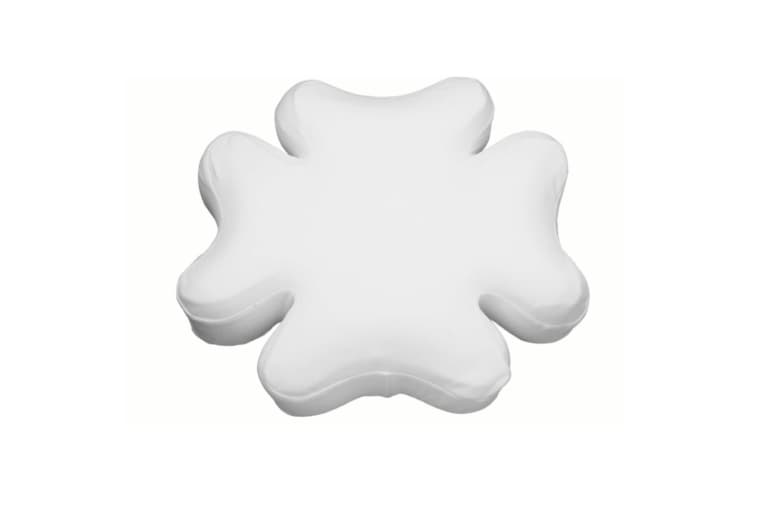
How to Choose a CPAP Pillow
Choosing the right CPAP pillow can be confusing. There is a wide range of pillows specifically designed for CPAP users, and other types of pillows — particularly wedge, cervical, and adjustable pillows — can also be helpful for CPAP users. We’ll walk you through the details you should know and factors to consider before making a purchase. By focusing on your own needs and arming yourself with information, it’s possible to choose a CPAP pillow that provides you with personalized comfort.
What to Consider When Purchasing a CPAP Pillow
CPAP pillows are often advertised with many marketing terms that have little concrete meaning. Comfort, for example, is highly personal — the “most comfortable” CPAP pillow might be perfect for one person and less than ideal for another.
To help our readers cut through the marketing talk, we’ll examine 11 critical factors to keep in mind when choosing a CPAP pillow. Some categories may be more important to you than other categories, but considering each of them will allow you to accurately judge what pillow might work for your needs.
Sleeping Position
Your preferred sleeping position is one of the most significant factors to consider when buying a CPAP pillow. Side sleepers should look for a pillow with cut-outs or curves to provide space for their mask, while people who sleep on their back often find that cervical pillows provide the stability and comfort they need. Some pillows are also shaped differently at the top and bottom so that combination sleepers can turn them as required. Stomach sleepers, on the other hand, usually find a nasal pillow mask most comfortable when paired with an adjustable memory foam or gel pillow.
Loft
A pillow’s loft refers to its height. While traditional pillows usually have one height, pillows designed for CPAP users often have dips and curves to provide cervical support or space for a CPAP mask. The ideal pillow loft also depends on your preferred sleep position, with side sleepers requiring a thicker neck support than back or stomach sleepers.
“Side sleepers tend to need a high-loft pillow for support and to fill the space beneath the head and neck to promote proper spinal alignment. Keep your head and neck in alignment at around 30 degrees with the help of a good pillow so your airway stays open during the night, allowing air to flow from your nose to your lungs without obstruction.”
– Sarah Silverman, Psy.D., a licensed psychologist and holistic sleep wellness consultant who treats patients in New York and Florida.
Mask Accommodation
There are several types of CPAP masks, with the most common varieties being full-face, nasal, and nasal pillow masks. Bulkier masks like full-face and nasal models require more accommodation, particularly for side sleepers, while nasal pillow masks tend to work well with most CPAP pillows. Before deciding on a CPAP pillow, consider whether the cut-outs or curves will allow enough space for your mask in your usual sleeping position.
Support
Most high-quality CPAP pillows offer excellent support through the cervical spine. This is thanks to their design, but also their materials — most CPAP pillows are made from memory foam, which provides soft comfort while still supporting the neck better than a traditional feather pillow. However, customers should make sure to choose a pillow with the right loft for their sleeping position in order to receive full support.
Firmness Level
CPAP pillows tend to range from medium to very firm. Most are intended to provide excellent cervical support while accommodating a CPAP mask, which requires firmer construction than a feather or down pillow. While softer options are available, most people quickly adjust to a firmer model and appreciate the additional support.
Pressure Relief
“Firm” doesn’t have to mean uncomfortable. A well-made CPAP pillow will contour against the head, allowing for a buoyant feeling with a supportive core. CPAP pillows made from memory foam tend to offer the best pressure relief, though latex and polyfoam options also provide gentle contouring.
Shape
CPAP pillows are available in a range of shapes meant to support the cervical spine and provide space for a CPAP mask. Different shapes may be more or less effective for the type of mask you have or for support in your preferred sleeping position. For example, a back sleeper looking for cervical stability may prefer deeply curved support around their neck, while a side sleeper mostly interested in space for their full-face mask may require a thinner central support with generous cut-outs at the sides.
Price
CPAP pillows are considered “non-essential” and are therefore not covered by insurance providers. Most cost between $30 and $75, though some models may be available for less and luxury versions can cost significantly more. As with other CPAP accessories, it’s crucial to choose the right pillow rather than the least expensive one. Pillows need to be replaced far less often than many other CPAP accessories, making them worth the investment.
Quality Materials
As with any other piece of bedding, a CPAP pillow should be made of high-quality materials. Most models use memory foam or polyfoam for support, both of which are synthetic materials that work extremely well for this use. However, latex options are available for people who prefer naturally derived materials for their bedding. A high-quality CPAP pillow will also have a soft, comfortable cover that can be washed.
Moldability
Some CPAP pillows are made from shredded memory foam that can be molded and adjusted for the right amount of support and mask space. Most CPAP pillows cannot be adjusted this way, so customers should decide on their adjustability preferences before narrowing down their options.
Temperature Regulation
Although memory foam and polyfoam are the ideal choice for most CPAP users, they do tend to retain heat throughout the night and can be uncomfortably warm for some people. Different manufacturers approach temperature regulation in different ways, with features like improved airflow and the use of gel memory foam.
Purchasing a CPAP pillow is similar to buying any other pillow, but there are enough unique factors to overwhelm and confuse many people. In this section, we’ll answer some of the most common questions our readers have about buying and caring for a CPAP pillow.
Frequently Asked Questions
How much do CPAP pillows cost?
CPAP pillows usually cost between $30 and $75, with an average price-point of around $50. A CPAP pillow that doesn’t fit your needs can lead to neck pain, as well as making it more likely for you to dislodge your mask during the night. Because of this, it’s crucial to buy the right pillow rather than the least expensive one. CPAP pillows aren’t covered by insurance providers, but a high-quality pillow can be bought on a budget by comparison shopping or waiting for a sale.
Do I need a prescription for a CPAP pillow?
CPAP pillows are considered an accessory item and do not require a prescription. Thanks to this, they can be purchased from many online and brick-and-mortar retailers who do not specialize in CPAP items. However, specialized CPAP retailers are likely to offer a wider selection at better prices than general retailers.
Can I wash my CPAP pillow?
Most foam CPAP pillows can be washed in the bathtub with warm water and a small amount of mild soap, but using and regularly washing a pillowcase is a better way of keeping it clean day-to-day. Some CPAP pillows come with a pillowcase or cover that hugs their cut-outs and curves, which can make for a more comfortable experience. If your CPAP pillow does not have a pillowcase, an oversized ordinary pillowcase made of a soft, stretchy material like cotton jersey is the best option. When washing the foam core of your pillow, squeeze out the excess water and leave it to dry rather than wringing it out or otherwise compressing the foam.
What other pillow styles are good for CPAP users?
In addition to cervical pillows and those with cut-out accommodation for masks, CPAP users may find that wedge-shaped pillows and adjustable shredded foam pillows work well for their needs. Different types of sleep apnea pillows fit different needs, so we recommend you speak to your sleep specialist about what design might work best for you. Wedge pillows, for example, can reduce gravity-related airway compression and therefore improve the effect of CPAP treatment in some people.

Still have questions? Ask our community!
Join our Sleep Care Community — a trusted hub of product specialists, sleep health professionals, and people just like you. Whether you’re searching for the perfect mattress or need expert sleep advice, we’ve got you covered. Get personalized guidance from the experts who know sleep best.


